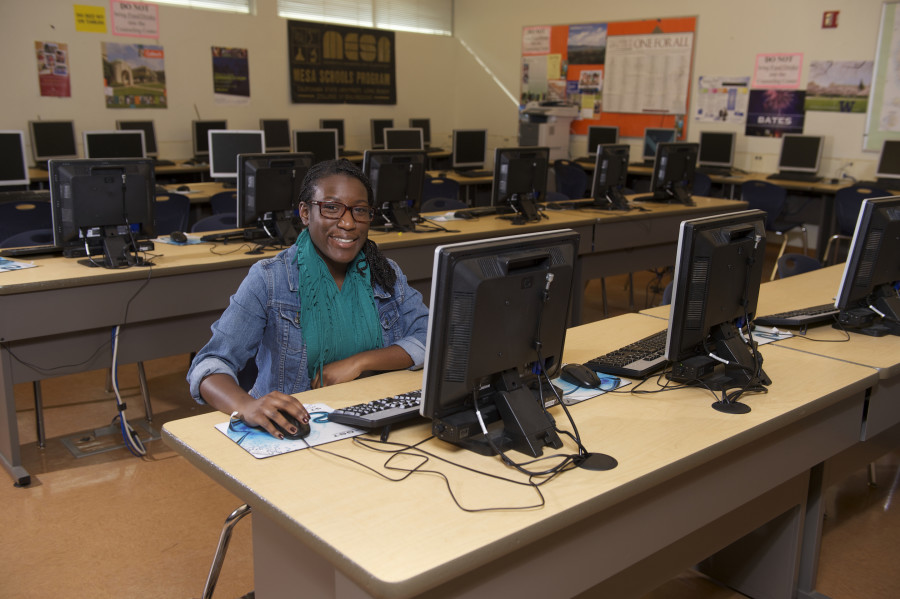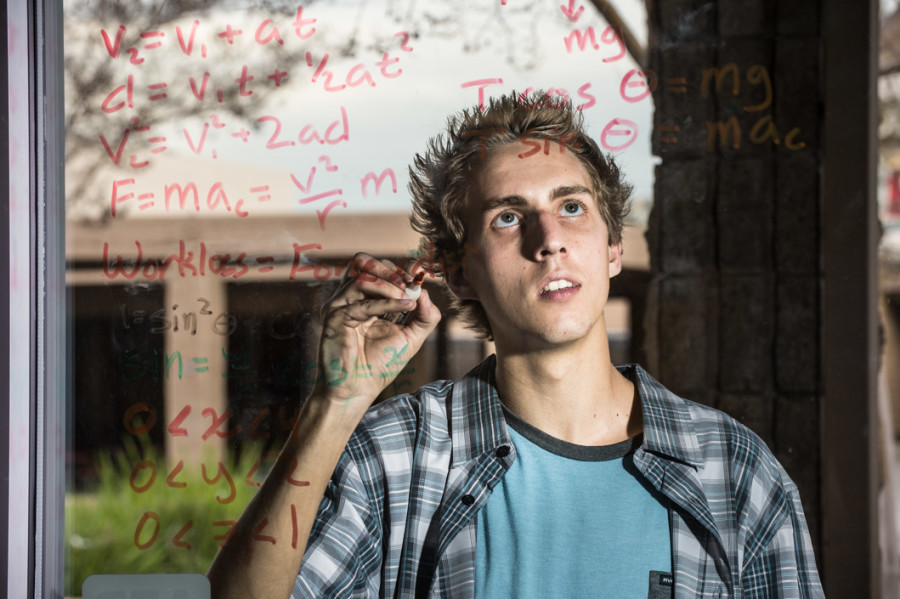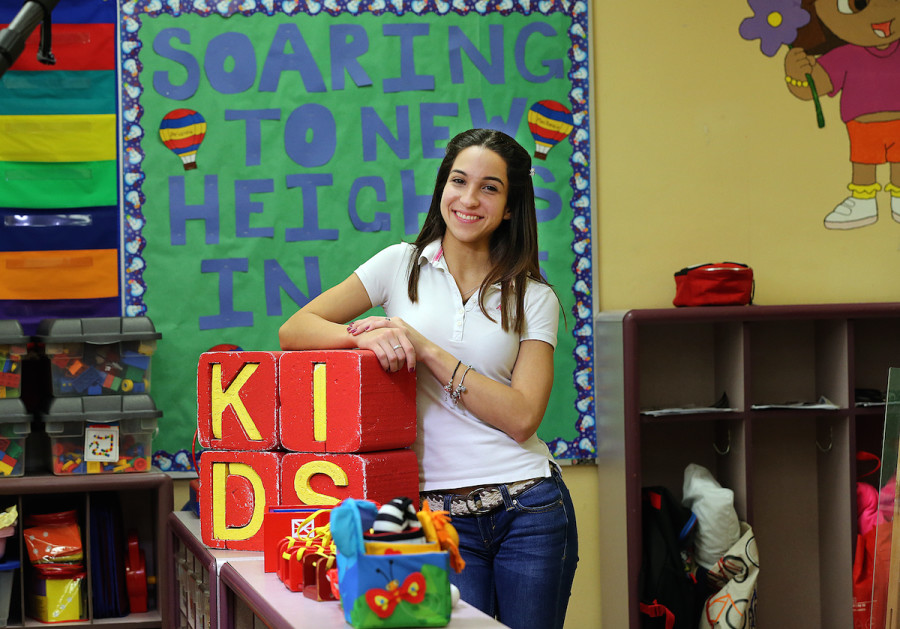Public education is riding out a rough storm. A system of “test, blame, and punish” continues to dominate educators, schools and students while perceptions of a system broken beyond repair fuel education’s harshest critics. But then we met high school seniors Makeda Gayle (Los Angeles, Calif.), Beatriz Tamames (Miami, Fla.), and Xander Luciano (Anaheim, Calif.).
These driven, smart, and spirited students represent so much that is right with public education. Preparing to bid farewell to their schools and ready to climb higher, they will graduate in June in the Class of 2015. And as they do, these students credit their teachers, guidance counselors, and public schools for helping nurture their aspirations, smoothing out uncertainties about life after high school, and readying them to be college bound. Among them are a future neuroscientist, a childcare worker, and a business owner and inventor. These are their stories.
 The Support of a Village
The Support of a Village
In June, Makeda Gayle will graduate from The California Academy of Mathematics and Science (CAMS), an elite public school in Carson, Calif. The commencement will represent the crowning achievement of Gayle’s high school career and the culmination of her father’s, diligence, commitment, and nudging.
It was Christopher Gayle’s foresight that first placed his nine-year-old fraternal twins Makeda and Maya on a STEM path, exposing the girls to engineers, robotics competitions, neuroscience camps, computer coding, and biology lectures. Even then, he saw his daughters’ potential and STEM’s bright promise to reward with jobs and boundless opportunity, those who were prepared.
Makeda, an honor student, had schools that recognized, nurtured, and rewarded her academic ability. But home was the first place she learned that her education and smarts had the power to transform and take her places.
“Growing up, my dad wasn’t very education focused, but he realizes that education can lead to many doors and so many opportunities. And I believe that, too,” says the teen who credits her father for helping to get her into a difficult and award-winning high school. For Christopher Gayle, a college degree represents the way forward. And he’s counting on it taking his girls “further in life” than he was able to go. The Gayle sisters will be heading to college in the fall—Makeda to study biology and Maya to pursue a nursing degree.
Nurturing “high achievers,” says Makeda, has been a family affair. Her mother is her ardent “supporter and cheerleader” and an “auntie in Maryland” is the school advisor who dispatches wisdom and scholarship information to her nieces on the West Coast.
For many students and their families, earning a spot at CAMS is unquestionably a badge of honor. Makeda knows it as a rigorous high school where learning happens, and opportunities abound.
“At CAMS, students enter smart and gifted, and then our teachers train us to be analytical thinkers. It can be a very difficult process, especially in physics and chemistry classes, but with their help, it’s up to us to figure out the answers.”
This is the CAMS way, says Gene Almeida who teachers government and economics. “The analysis and problem-solving skills they’re learning here will pay off for them in college.”
Makeda and her CAMS classmates are among public school’s best, “representing the top 1 percent of high school students in the state of California and the top 10 percent of middle schoolers,” adds Almeida, who was recently CAMS’ dean of students. They are also students “who beat the odds, performing better than statistically expected for their level of poverty,” concluded a 2014 Newsweek ranking of standout high schools in the nation.
Located on the campus of California State University at Dominguez Hills, CAMS offers students a bridge to higher education and a preview of what college has to offer. College-going is high among CAMS graduates: last year, 96 percent of its seniors moved on to a four-year university, with the remaining students enter community college, says CAMS Principal Christopher Brown.
But come June 10, graduation day, Makeda can exhale.
“When I look back,” says Makeda, “I can say that graduation was hard won. CAMS is probably one of the toughest schools to go to.”
- B. Denise Hawkins
 Full Speed Ahead!
Full Speed Ahead!
Two years ago, Xander Luciano was asked to substitute teach a computer and design software class to school district employees and industry employees. He was just 16.
Scanning the room, he guessed his students were in their 30s with well-established careers. “They’re paying me to be here to teach,” he thought. Based on some students’ expressions, they were thinking the same thing.
Today, Luciano is a month shy of graduation. “You don’t expect someone so young to be teaching, but I was comfortable with it. I gave them a few minutes to get over it and we got into the lesson,” he says confidently.
Some of Luciano’s confidence comes from his experiences at Esperanza High School where the Anaheim, Calif., senior has immersed himself in high-end career and technical programs that incorporate heavy doses of academics, including math, writing, and public speaking.
Luciano dreams of being an inventor and business owner. “I’ve always had this little nag inside of me to create,” says the teen who was accepted into California Polytechnic State University in Pomona.
Luciano has been interested in all things mechanical since childhood. By the time he saw Esperanza’s manufacturing shop, he knew he wanted to enroll.
“It was astonishing!” he exclaims. “I walked in and thought, ‘Wow, this school has equipment I’ve seen on TV, most of it state of the art,” he says, explaining that four years ago 3-D printers were on the cusp of new technology and the school had two of them.
Luciano says the manufacturing program helped him digest upper level math concepts, such as three-dimensional coordinate systems and planes or unparalleled lines and vectors. When it was time for him to attend AP physics and chemistry classes, he already had a deep understanding of the material.
Teachers have helped to shape his academic experience, too. Referring to many public school learning environments that require teaching to the test without giving students a core understanding of the material, Luciano says of Esperanza, “It’s not a plug and chug mentality where you use these numbers to get this equation and you use that equation to get this answer. You can use any equation, but sometimes one might require an additional step. If you have a core understanding of the material you can solve any problem with different answers.”
Luciano credits AP physics teacher Robert Proctor for being one of the educators who helped him during high school. Proctor, says that today’s learning environment requires students to learn mostly about concepts.
“We have a whole generation of students who think that teaching to the test is normal,” says the 18-year teacher. “Curiosity has been thrown in the trash and it’s a one-size-fits-all, teach to the test mentality.” Proctor longs for the return of critical thinking, content, and application. But for Luciano, Proctor says he’s a ball of fire. “He’s driven by the challenge of learning and gets excited about everything we do!”
-Brenda Álvarez
 A Head Start
A Head Start
Toddlers led Beatriz Tamames to her post-high school plans when she spotted a group of them on the grounds of Miami’s Hialeah Senior High School in Miami, Fla. “I don’t know what they were doing,” she says today. I think they were hunting for eggs because it was around Easter. All I knew was it looked fun and I wanted in!”
The children were part of the early childhood education center in Hialeah’s education academy, which provides students with hands-on training and certification to enter the profession. When she graduates in 2015, Tamames will receive a Child Development Associate credential, making her eligible for a job immediately following graduation.
Tamames serves as the childcare provider for cousins ages 12 and 5, and says they were her “inspiration to teach smaller kids.” When the high school senior saw the toddlers at Hialeah, she was able to connect the dots to the enjoyment she experienced caring for her young relatives.
“I didn’t know early education was offered at Hialeah High, but I took advantage of it the very next year,” says Tamames, who plans to enroll at Miami Dade Community College and sign up for its early childhood education program. Ultimately, she hopes to own her own childcare center.
Neither current nor accurate data exists on the number of centers in public schools. However, the U.S. Bureau of Labor Statistics reported in 2012 that elementary and secondary schools employed 11 percent of the 1.3 million childcare workers.
Hialeah has offered childcare service to area residents since 2002. The program was created for students interested in pursuing a career in education.
The graduating senior credits one of her teachers, Elizabeth Weaver, for her success. “She’ll work with you until you truly understand what you’re doing,” Tamames says of her early childhood education instructor.
An important attribute for Tamames, who says school didn’t come easy for her. “Coming from a Cuban family there was little help at home, learning English as a child was hard for me,” she says. “I’ve learned how to push myself and not give up.”
Weaver says Tamames is one of the hardest working students enrolled in the Early Childhood Education program. “When it’s her turn to work with children…she is always prepared.”
The school’s principal, Heriberto Sánchez, says it’s about having options. “We want to provide our students with a diverse curriculum so that there’s something for everyone.”
The program has grown, too. Ten years ago, six students completed the program. Today, there are 20 students who will be ready to work at an early childhood education center.
Tamames says that programs like these benefit the entire school community: “Children get a jump-start on their education. Parents have peace of mind after noticing how much better their child does on social and educational levels. And students—like me—get a head start on their careers.”
-Brenda Álvarez








